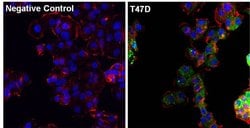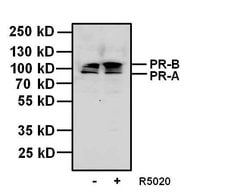Learn More
Invitrogen™ Progesterone Receptor Monoclonal Antibody (alpha PR-22)


Mouse Monoclonal Antibody
Supplier: Invitrogen™ MA1412
Description
MA1-412 detects the A and B forms of progesterone receptor from chicken and some species of turtles. This antibody does not cross-react with estrogen receptor or glucocorticoid receptor. MA1-412 has been successfully used in Western blot and immunoprecipitation procedures. By Western blot, this antibody detects a 78 kDa protein representing the A form and a 110 kDa protein representing the B form of PR. The proportion of receptor bound by this product is significantly greater than catalog number MA1-411 due to the binding of both the A and B form of PR. Protein A can effectively be used with this product in immunoprecipitation experiments. MA1-412 detects the A and B forms of progesterone receptor from human, chicken and some species of turtles. This antibody does not cross-react with estrogen receptor or glucocorticoid receptor. The MA1-412 immunogen is progesterone receptor purified from chick oviduct cytosol. Reconstitute with PBS.
The progesterone receptor (PR) is a member of the steroid family of nuclear receptors. The PR mediates the physiological effects of progesterone, which plays a central role in reproductive events associated with the establishment and maintenance of pregnancy. PR is found as a 94 kDa protein (Form A) or a 120 kDa protein (Form B) due to the use of alternative translation initiation sites. PR-B is the transcriptionally active form and is responsible for activating genes for the maintenance of the endometrium, maintenance of pregnancy, and inhibition of ovulation. PR-A is identical to PR-B except for a 165 amino acid deletion at the N-terminus. This deletion exposes a 140 amino acid inhibitory domain (ID) that acts as a repressor of steroid hormone transcriptional activity. In its inactive state, PgR forms a multiprotein complex which includes heat shock proteins and immunophins. Upon binding of progesterone hormone to its receptor, there is a conformational change that allows dimerization and binding of the receptor to progesterone response elements (PRE) sequences, resulting in activated transcription. A Null mutation in the PGR gene leads to pleiotrophic reproductive abnormalities.
Specifications
| Progesterone Receptor | |
| Monoclonal | |
| 1 mg/mL | |
| PBS with 0.05% sodium azide | |
| P06401, P07812 | |
| PGR | |
| Progesterone receptor purified from chick oviduct cytosol. | |
| 100 μg | |
| Primary | |
| Human, Chicken, Reptile | |
| Antibody | |
| IgG2b |
| Gel Shift, Immunoprecipitation, Western Blot, Immunocytochemistry | |
| alpha PR-22 | |
| Unconjugated | |
| PGR | |
| 9930019P03Rik; BB114106; ENSMUSG00000074510; LOW QUALITY PROTEIN: progesterone receptor; NR3C3; Nuclear receptor subfamily 3 group C member 3; p4 receptor; PGR; pot. alt. progesterone receptor; putative; PR; PR-A; PR-B; Progesterone receptor; progesterone receptor A; progesterone-receptor; putative form B; steroid hormone receptor; testicular progesterone receptor; unnamed protein product | |
| Mouse | |
| Purified | |
| RUO | |
| 396198, 5241 | |
| -20°C, Avoid Freeze/Thaw Cycles | |
| Lyophilized |
Your input is important to us. Please complete this form to provide feedback related to the content on this product.

